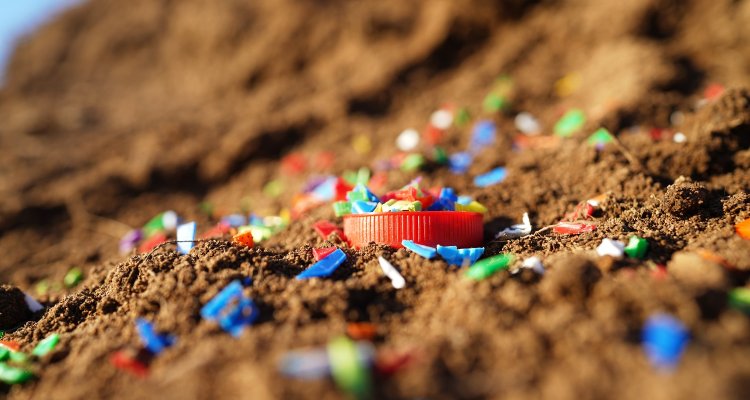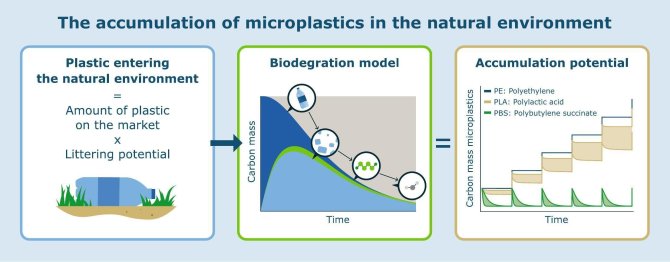
News
Plastics Accumulation Indicator: model to predict accumulation of microplastics
All over the world, plastics end up in nature, whether intentionally or not. This may be because the plastic is used in the natural environment (like agricultural plastics), as the result of wear and tear (car tyres, for example) or when it is littered. If the plastic does not subsequently biodegrade, it will accumulate in nature: in the form of large pieces to microplastics. Often the biodegradation process is very slow, with more plastic accumulating in the meantime. Except: not every type of plastic contributes equally to that accumulation. Rapidly biodegradable plastics disappear much faster than traditional plastics. How do you map that degradation and the effect on accumulation? Together with their team at Wageningen University & Research, researchers Marieke Brouwer and Evelien Maaskant have developed a model to do just that.
Marieke Brouwer: "The Plastics Accumulation Indicator is a model we developed to be able to predict the accumulation of different types of plastics in the environment. It uses data about CO2 evolution during the biodegradation of polymers, i.e. plastics, and can then visualise what the concentration of microplastics will be at different moments of decomposition in the environment. In other words, we can now predict how long and in what quantity different types of plastics, fossil and biobased, can still be found in nature. And the amount of (micro)plastics to which people and animals will therefore be exposed due to the application of a particular polymer in a specific product."
Evelien Maaskant: "And we can do that in scenarios in which there is a continuous flow of litter, for example with packaging materials (e.g. candy wrappers), as well as when it happens in (seasonal) peaks, as with agricultural plastics."
More information for producers and policy makers
Maaskant: "Until now, it wasn’t entirely clear what the environmental impact of different types of plastics was when they end up (unintentionally) in nature at the end of their use. There are standards, but they have a binary outcome: a product either meets the standard or not. But what you actually want to know is the extent to which something is or is not satisfactory. Because that provides more information about the real environmental impact. Plastics will always end up in the environment, intentionally or not, so you want to know what the consequences will be. The Plastics Accumulation Indicator can now predict that."
Brouwer: "Product developers can factor this into the Life Cycle Assessments (LCAs) of their products and thus make a more responsible choice. And it helps policy makers, both at European and national level. They develop guidelines and regulations, providing guidance on which materials can be used for which applications. The use of biodegradable plastics is approached with some caution in European legislation, due to a possible risk that these plastics would encourage littering. But some biological plastics biodegrade completely and incredibly quickly, so in theory these would result in very few or almost no microplastics in the environment. Policy makers now tend to view them as all the same purely due to the lack of information about them. The Plastics Accumulation Indicator provides that information.”

Developed in the lab, but potentially widely applicable
Maaskant: "Currently, the model has been tested with data from biodegradation experiments in soil and with a temperature around 25 degrees. By using experimental biodegradation curves, we can extend the model to other conditions. We have now used publicly available data, but if the data is available, we can also study how it works, for example, in salt or fresh water or at different temperatures. Perhaps even in the conditions that are present in the human body. "
Brouwer: "Unlike current models, this model assumes actual biodegradation of polymers. Many models merely assume that particles become smaller and smaller and then suddenly disappear in the final phase. That is obviously not the case. This model looks at the actual conversion of the plastic into CO2, thus indicating whether or not plastics have actually disappeared. That immediately shows the potential of biodegradable plastics which, unlike traditional plastics, completely biodegrade in nature. Sometimes very fast. This model provides good insight into that."
The Plastics Accumulation Indicator is available for producers and policy makers. Would you like to know more? Please contact Marieke Brouwer, scientist Sustainable Products & Systems: m.brouwer@wur.nl.
And would you like to work with biobased and biodegradable plastics yourself? At Wageningen University & Research, we have the knowledge and facilities to support conversion from traditional to biobased and biodegradable plastics. Contact Karin Molenveld, Renewable Plastics programme manager: k.molenveld@wur.nl